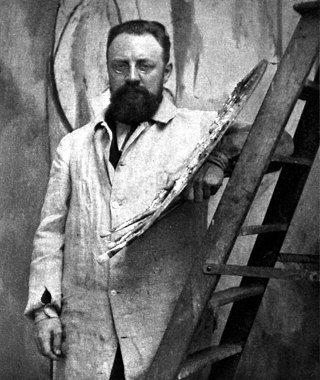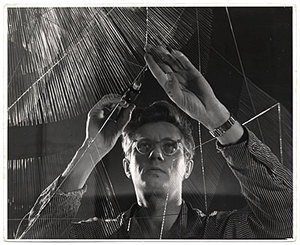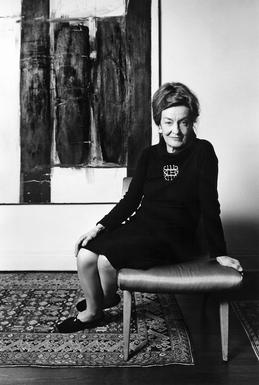Related Research Articles

Pablo Ruiz Picasso was a Spanish painter, sculptor, printmaker, ceramicist, and theatre designer who spent most of his adult life in France. One of the most influential artists of the 20th century, he is known for co-founding the Cubist movement, the invention of constructed sculpture, the co-invention of collage, and for the wide variety of styles that he helped develop and explore. Among his most famous works are the proto-Cubist Les Demoiselles d'Avignon (1907) and the anti-war painting Guernica (1937), a dramatic portrayal of the bombing of Guernica by German and Italian air forces during the Spanish Civil War.

Henri Émile Benoît Matisse was a French visual artist, known for both his use of colour and his fluid and original draughtsmanship. He was a draughtsman, printmaker, and sculptor, but is known primarily as a painter.

Alexander Calder was an American sculptor known both for his innovative mobiles that embrace chance in their aesthetic, his static "stabiles", and his monumental public sculptures. Calder preferred not to analyze his work, saying, "Theories may be all very well for the artist himself, but they shouldn't be broadcast to other people."

Barnett Newman was an American artist. He has been critically regarded as one of the major figures of abstract expressionism, and one of the foremost color field painters. His paintings explore the sense of place that viewers experience with art and incorporate the simplest forms to emphasize this feeling.

Louise Nevelson was an American sculptor known for her monumental, monochromatic, wooden wall pieces and outdoor sculptures. Born in the Poltava Governorate of the Russian Empire, she emigrated with her family to the United States in the early 20th century. Nevelson learned English at school, as she spoke Yiddish at home.

Alexander Porfyrovych Archipenko was a Ukrainian-American avant-garde artist, sculptor, and graphic artist, active in France and the United States. He was one of the first to apply the principles of Cubism to architecture, analyzing human figures into geometrical forms.

Kinetic art is art from any medium that contains movement perceivable by the viewer or that depends on motion for its effects. Canvas paintings that extend the viewer's perspective of the artwork and incorporate multidimensional movement are the earliest examples of kinetic art. More pertinently speaking, kinetic art is a term that today most often refers to three-dimensional sculptures and figures such as mobiles that move naturally or are machine operated. The moving parts are generally powered by wind, a motor or the observer. Kinetic art encompasses a wide variety of overlapping techniques and styles.

George Warren Rickey was an American kinetic sculptor.

Richard Lippold was an American sculptor, known for his geometric constructions using wire as a medium.

Assemblage is an artistic form or medium usually created on a defined substrate that consists of three-dimensional elements projecting out of or from the substrate. It is similar to collage, a two-dimensional medium. It is part of the visual arts and it typically uses found objects, but is not limited to these materials.

Cancer (♋︎) is the fourth astrological sign in the zodiac, originating from the constellation of Cancer. It spans from 90° to 120° celestial longitude. Under the tropical zodiac, the Sun transits this area between approximately June 22 and July 22.
Events from the year 1939 in art.

Nancy Graves was an American sculptor, painter, printmaker, and sometime filmmaker known for her focus on natural phenomena like camels or maps of the Moon. Her works are included in many public collections, including those of the National Gallery of Art, the Brooklyn Museum of Art, the Smithsonian American Art Museum, the National Gallery of Australia (Canberra), the Des Moines Art Center, Walker Art Center (Minneapolis), and the Museum of Fine Arts. When Graves was just 29, she was given a solo exhibition at the Whitney Museum of American Art. At the time she was the youngest artist, and fifth woman to achieve this honor.
Rachel Harrison is an American visual artist known for her sculpture, photography, and drawing. Her work often combines handmade forms with found objects or photographs, bringing art history, politics, and pop culture into dialogue with one another. She has been included in numerous exhibitions in Europe and the US, including the Venice Biennale, the Whitney Biennial and the Tate Triennial (2009). Her work is in the collections of major museums such as The Museum of Modern Art, New York; Metropolitan Museum of Art, New York; Hirshhorn Museum and Sculpture Garden, Washington, D.C.; and Tate Modern, London; among others. She lives and works in New York.

Lobster Telephone is a Surrealist object, created by Salvador Dalí in 1936 for the English poet Edward James (1907–1984), a leading collector of surrealist art. In his 1942 book The Secret Life of Salvador Dalí, Dalí wrote teasingly of his demand to know why, when he asked for a grilled lobster in a restaurant, he was never presented with a boiled telephone.

Dorothy Canning Miller was an American art curator and one of the most influential people in American modern art for more than half of the 20th century. The first professionally trained curator at the Museum of Modern Art (MoMA), she was one of the very few women in her time who held a museum position of such responsibility.
Lynn Russell Chadwick, was an English sculptor and artist. Much of his work is semi-abstract sculpture in bronze or steel. His work is in the collections of MoMA in New York, the Tate in London and the Centre Georges Pompidou in Paris.

Modern sculpture is generally considered to have begun with the work of Auguste Rodin, who is seen as the progenitor of modern sculpture. While Rodin did not set out to rebel against the past, he created a new way of building his works. He "dissolved the hard outline of contemporary Neo-Greek academicism, and thereby created a vital synthesis of opacity and transparency, volume and void". Along with a few other artists in the late 19th century who experimented with new artistic visions in sculpture like Edgar Degas and Paul Gauguin, Rodin invented a radical new approach in the creation of sculpture. Modern sculpture, along with all modern art, "arose as part of Western society's attempt to come to terms with the urban, industrial and secular society that emerged during the nineteenth century".

The Snow Flurry design was used by American artist Alexander Calder for at least seven mobiles between 1948 and 1959. A monumental design composed of white disks of varying sizes are connected on different branches and levels to reflect a snow flurry in Calder's distinct Modernist style.
References
- ↑ Lipman, Jean; Franc, Helen Margaret (1976). Bright stars: American painting and sculpture since 1776. Dutton, ISBN 978-0-525-07147-1
- ↑ Morgan, Ann Lee (2007). The Oxford dictionary of American art and artists, p. 73. Oxford University Press US, ISBN 978-0-19-512878-9
- ↑ Moyle, Peter B.; Moyle, Marilyn A. (1992). Fish imagery in art 28: Calder's Lobster Trap and Fish Tail. Environmental Biology of Fishes, Volume 35, Number 2, 204 doi : 10.1007/BF00002194
- 1 2 Finkelstein, Allix (September 28, 2007). Intimate at MoMA. New York Sun